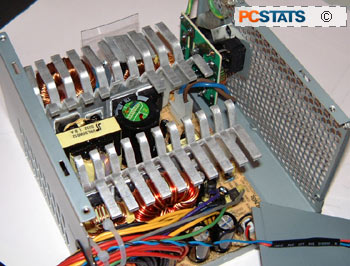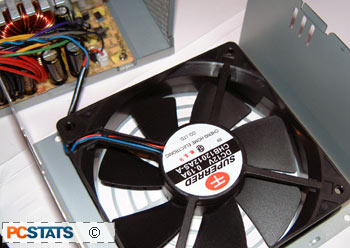 To help keep the power supply running at the highest efficiency and reliability,
Seasonic have integrated a Forward converter into the Super Tornado. A
forward converter is a DC to DC converter that stores electricity in the
output inductor instead of the transformer. The company claims this method is
more efficient then the traditional half bridge design which is found in most
other power supplies on the market.
To help keep the power supply running at the highest efficiency and reliability,
Seasonic have integrated a Forward converter into the Super Tornado. A
forward converter is a DC to DC converter that stores electricity in the
output inductor instead of the transformer. The company claims this method is
more efficient then the traditional half bridge design which is found in most
other power supplies on the market.
Forward Converters control electricity via a Power
MOS (Metal Oxide Semiconductor) instead of a bipolar transistor. The advantage here is
that the PowerMOS is much smaller and switches must faster than the transistor which tends
to increase the overall powersupply efficiency by a finite amount.
Forward Converters are
also a lot faster at switching voltages (the rate which DC
voltages are switched on and off). The Seasonic Super Tornado can switch at 100KHz while
standard PSU's apparently do the same process at 32KHz. Another advantage of using Power
MOS is that it operates better over a wider temperature range while bipoloar transistors can lose
stability at elevated temperatures should a fan fail for example.
Power Factor Correction:
Power
factor is
the ratio of actual AC input value when compared to power consumed by the various
PSU system circuitry. Power supplies without PFC usually only have an actual
PF rating of 50% (the rest is turned into heat energy). With PFC, first and foremost
you'll notice that your system has better voltages as the onboard circuit controls
the individual lines. An active PFC power supply will also draw less power,
and will cost you less in electric bills over time.
 With the Seasonic Super Tornado there's actually an onboard circuit that controls where
electricity is going and how much current is to be applied. Because of
this setup, the efficiency of the Super Tornado PSU is listed at "close to 99%"
by the manufacturer.
With the Seasonic Super Tornado there's actually an onboard circuit that controls where
electricity is going and how much current is to be applied. Because of
this setup, the efficiency of the Super Tornado PSU is listed at "close to 99%"
by the manufacturer.
The
Super Tornado 400W PSU does look quite special at
first glance. As I'm sure you can see instead of going with multiple smaller fans
which generate more noise, Seasonic have used one large (SuperRed CHB12012AS-A ) 120mm which pushes around 60 CFM of air while
spinning at a top speed of 1700 RPM.
To help improve system exhaust, Seasonic went with a Honey Comb grill design because
it tends to offer less resistance to airflow. If you're looking to tweak your
voltages I think you'll have to look elsewhere as
the power supply does not have any internal potentiometers which are enthusiast serviceable.
